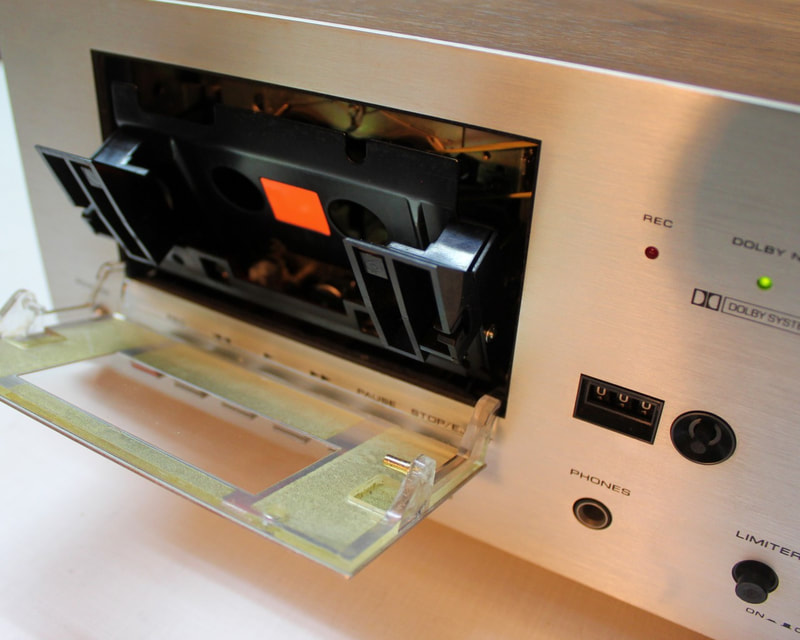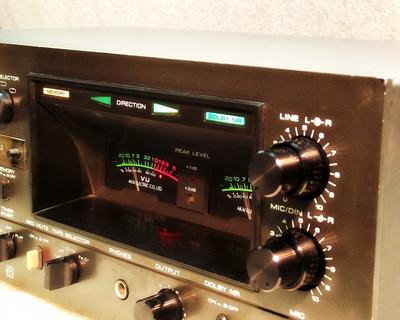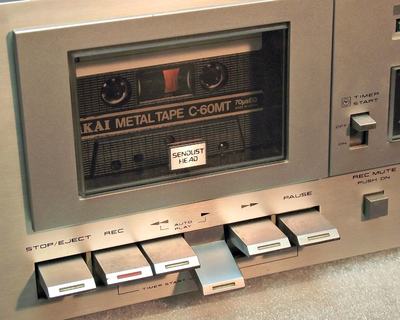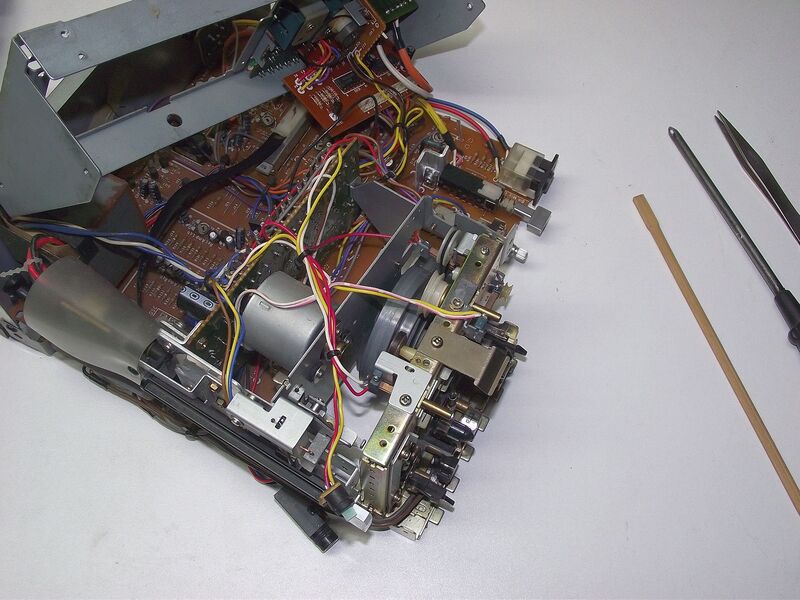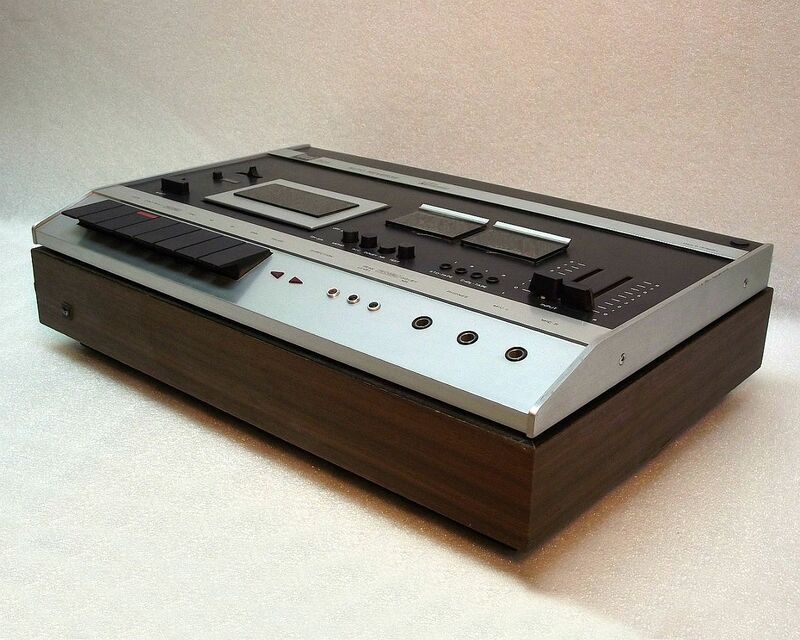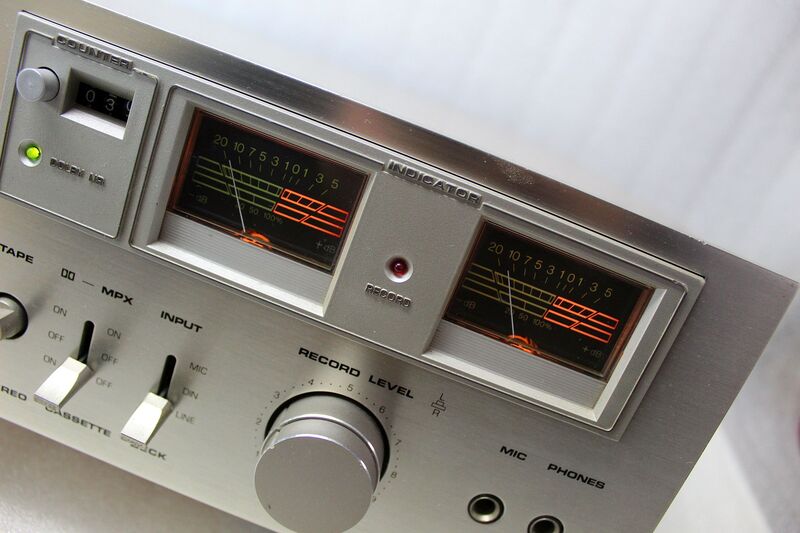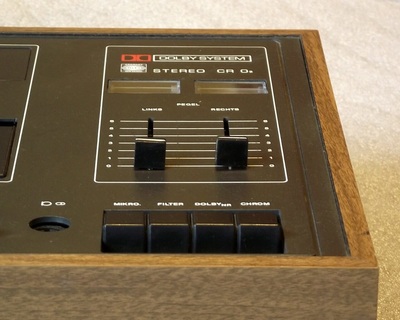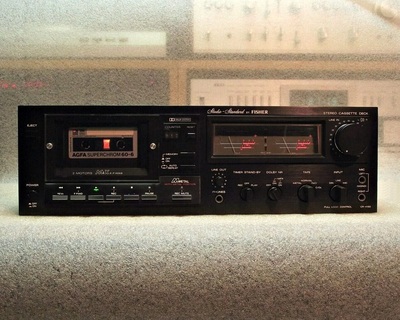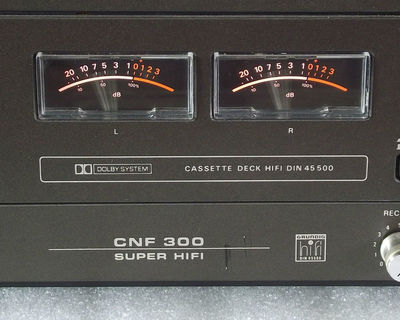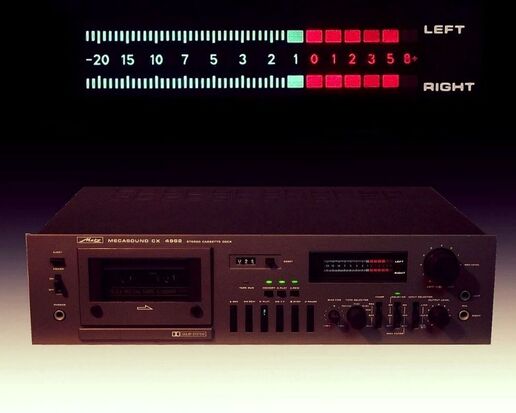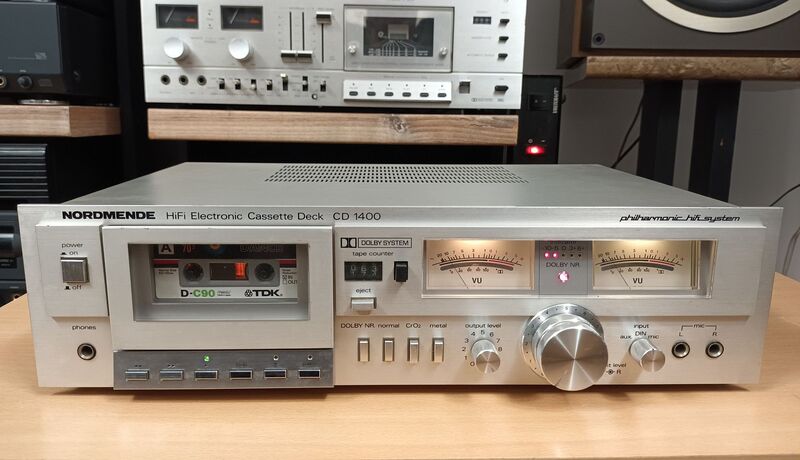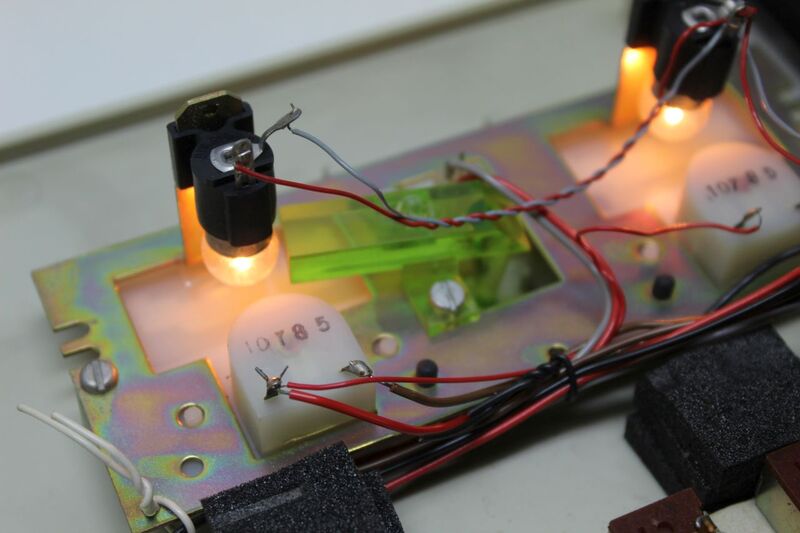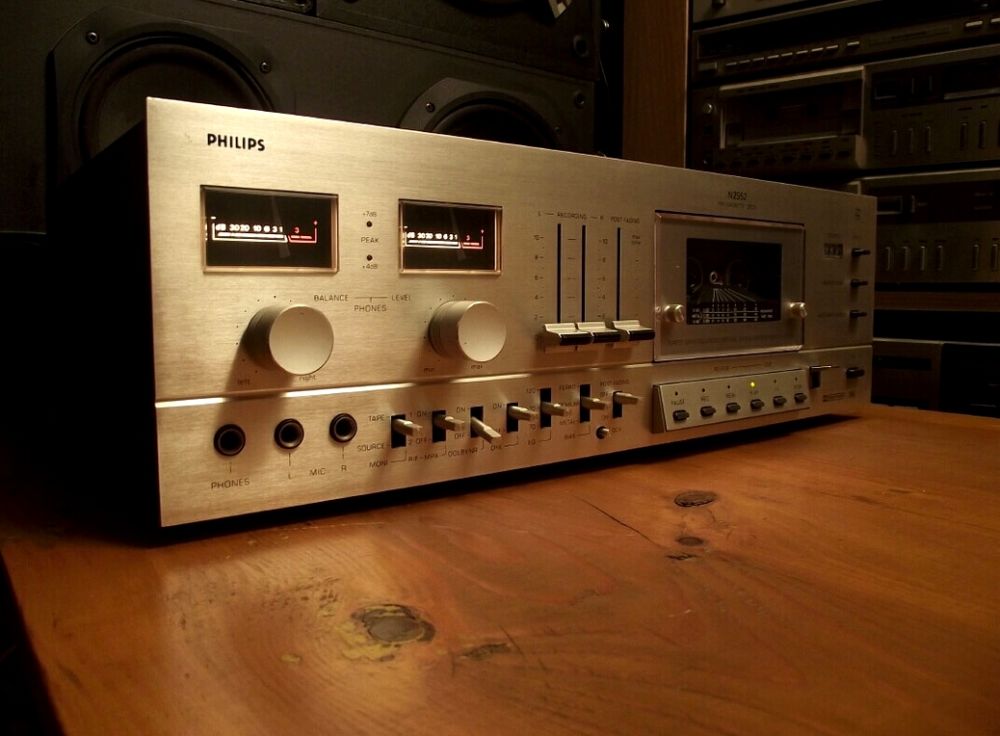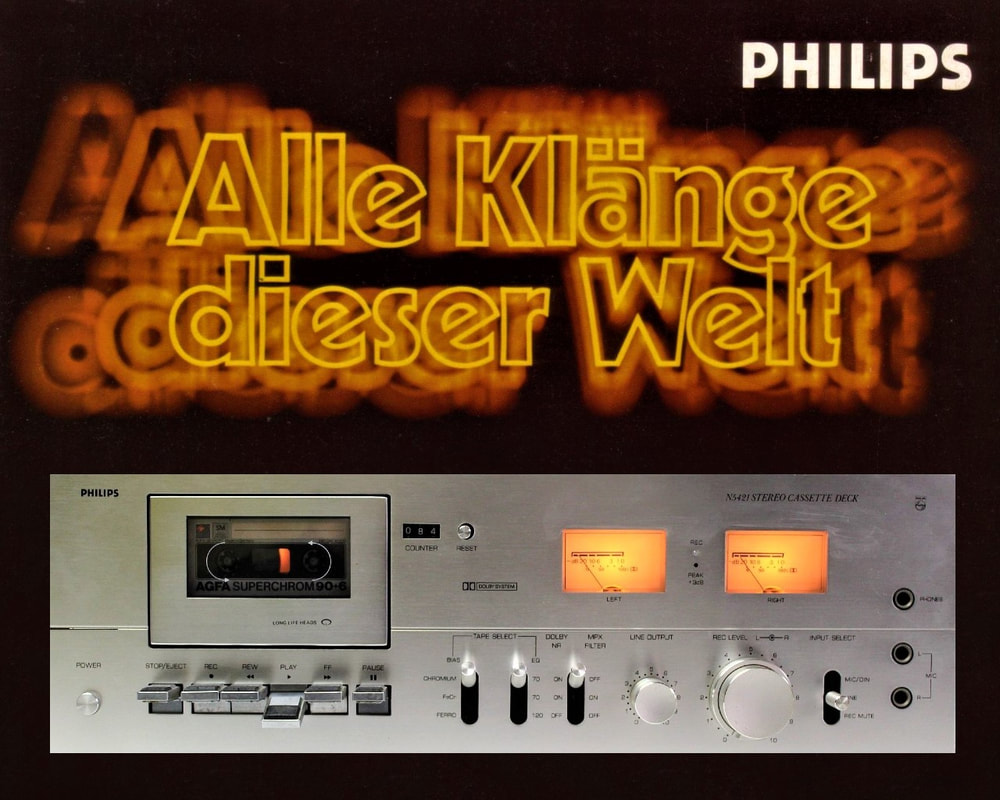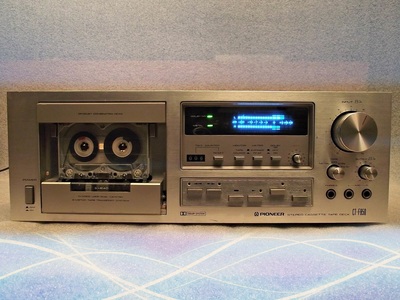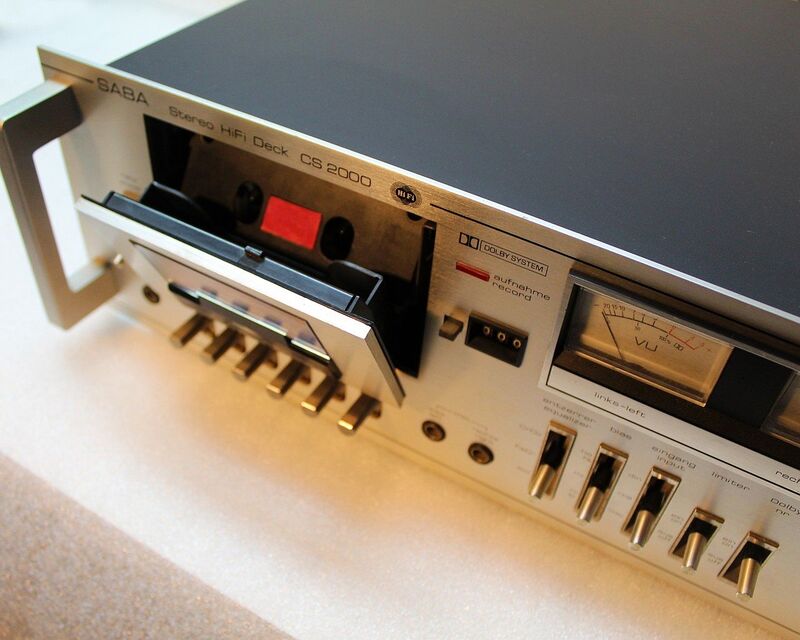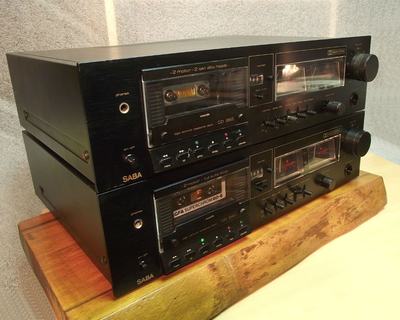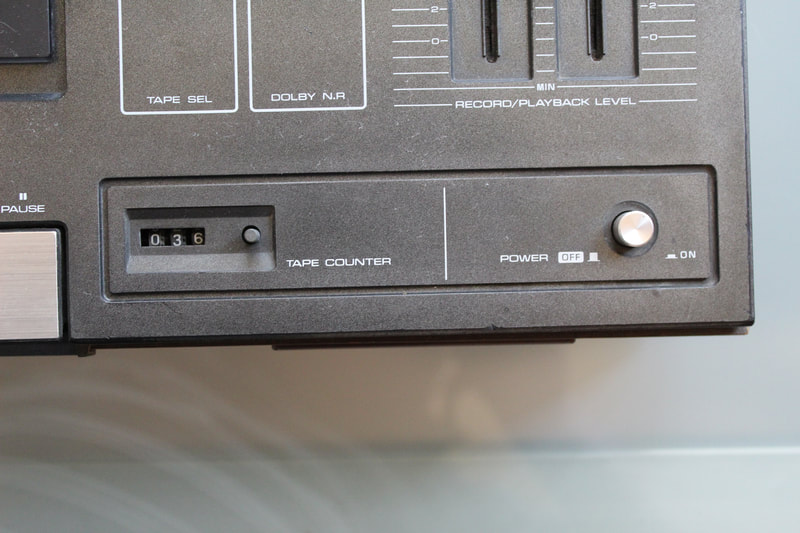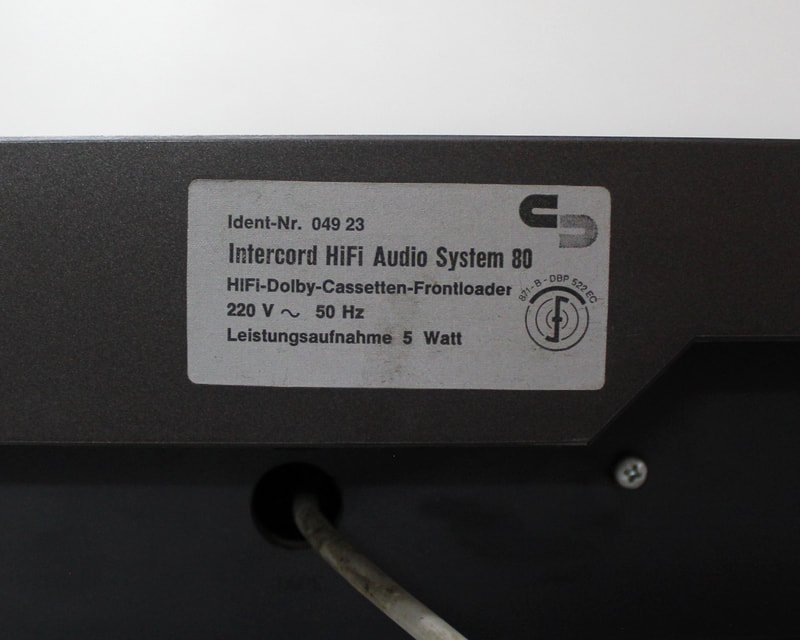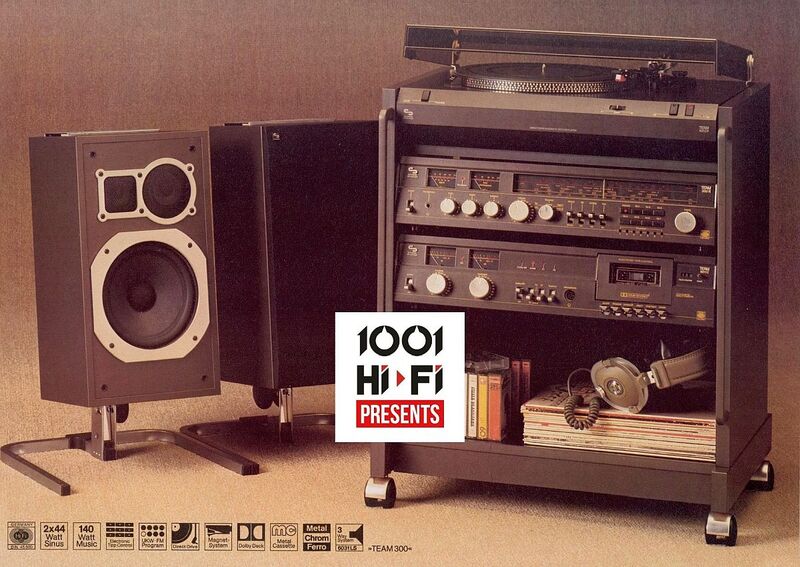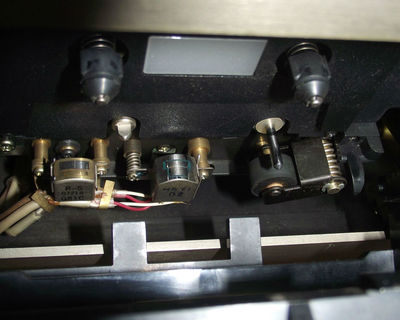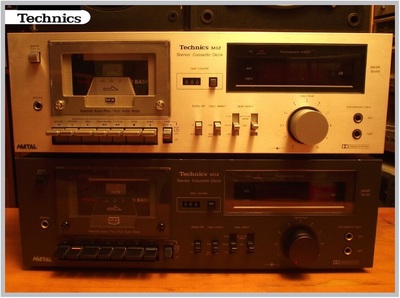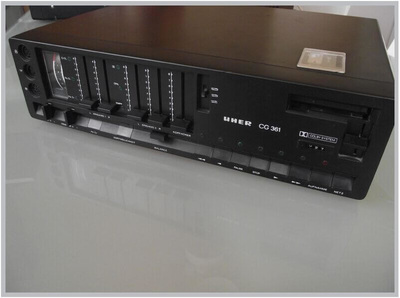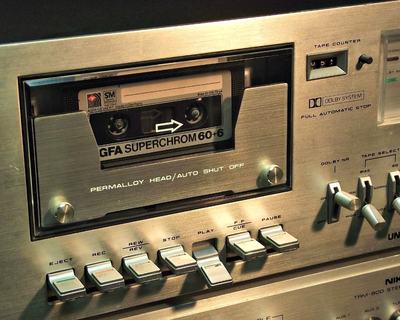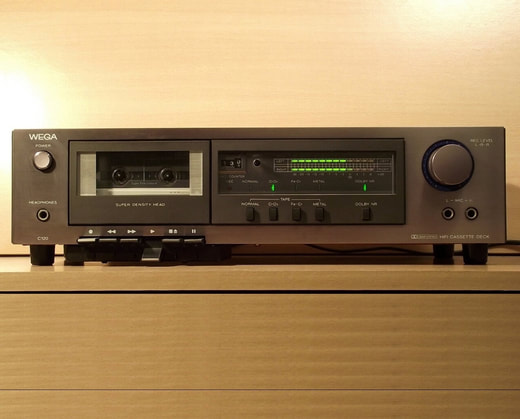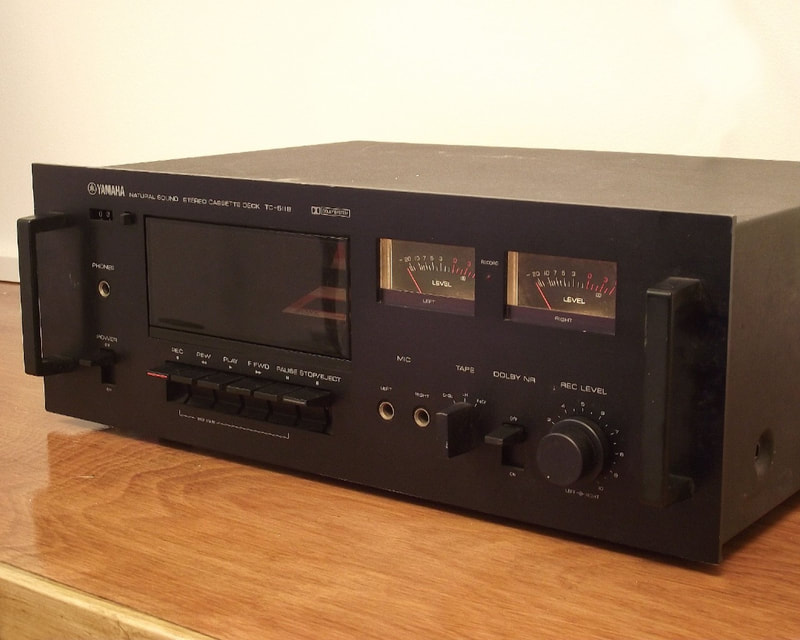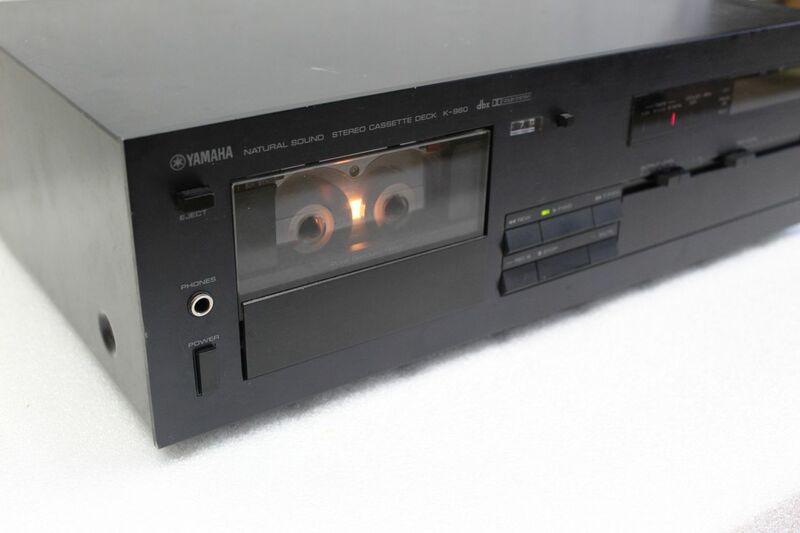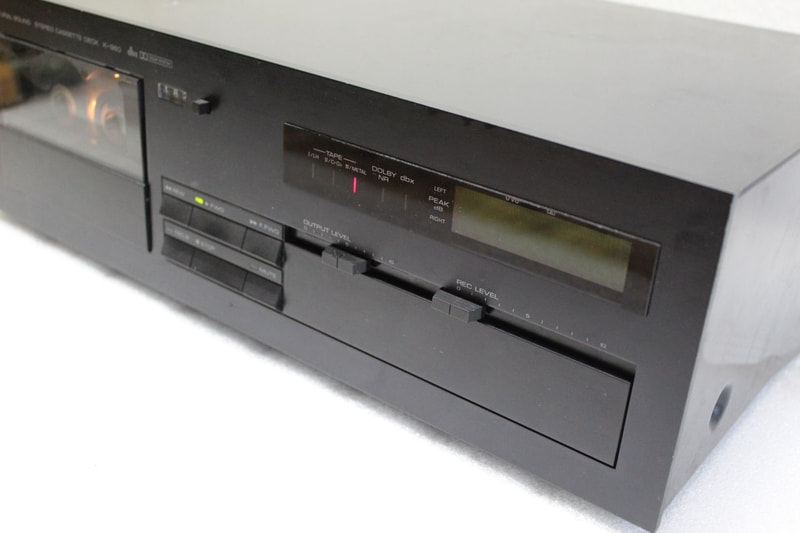CASSETTE DECK 1971 - 1980
The 1001 Hi-Fi Collection
AKAI CS-705D (1976)
The CS-705D cassette recorder was introduced by Akai in 1976. Even though it's only a basic model it has a very solid construction. This is actually how things were made before manufacturers started to find ways for reducing cost of production. Externally the CS-705D has an elegant look with brushed aluminium front panel, smooth turning metalic record level knobs and wood case. Moving to the inside we will find a mechanically operated one motor transport with multi belt and idler transmission, a characteristic of these early mechanisms. Even if they look complex in construction, with some care and attention they can be made to run just as smooth as 47 years ago. The heads of the CS-705D are permalloy heads that can handle Low-Noise (Normal), Chrome and Ferro-Chrome tapes. Frequency response is 35-14000 Hz (LH), 35-15000Hz (Chrome) and 30-17000 (FeCr). Recordings can be made with (or without) the use of the Dolby noise reduction circuit while the recording level can be adjusted independently for left and right channel. From a distance the VU meters might appear slightly small but that's only because of the very large front panel (440*165 mm). In practice these are very nice, easy to read VU meters with a "classic" warm lighting. On the front panel we can find two microphone inputs while at the back we can find both RCA and 5-pin DIN standard sockets with a selector switch for the one to be used. The CS-705D was also available in black finish and it was usually presented as a matching unit for Akai receivers. A full system could be built with the addition of a turntable, all that can be installed in a so-called ProPower rack from Akai. One interesting (and important aspect during disassembly) is the way the cassette door is constructed. The decorative front is mounted from behind, to the front panel, and for disassembly but also cleaning the heads this must be "unhooked" from the door itself.
Cover Photo Art: Professional Background - Published 15th September 2023
Cover Photo Art: Professional Background - Published 15th September 2023
AKAI CS-702D II (1977)
The AKAI CS-702D II was the entry-level, front-loading cassette deck in the 1977 model range. It was also smaller than the usual full-size components, having only a 38 cm wide front panel. In order to build a full system various racks were available, such as the RV-100, RM-100 or RM-H-100 (for components with optional rack handles). These could accommodate the cassette deck, amplifier and tuner, all 38 cm wide components. The CS-702D II is a basic cassette recorder featuring a one DC motor mechanism and Permalloy heads in a 2 head configuration system. Wow and flutter is <0,08% (WRMS) with a frequency response of 40-15000 Hz (chrome tape). For noise reduction the NE545B Dolby integrated circuit was adopted. The cassette deck was factory adjusted for optimal performance when using FUJI FL C-60 (low noise tape) and TDK SA C-60 (chrome tape). Obviously, the deck will offer very good results with quality tapes from major manufacturers such as Akai, Fuji, maxell, Scotch, Sony or BASF (the specific models are listed in the user manual). The cassette recorder also features a limiter circuit that will limit recording input level and prevent over-recording and cut distortion when recording at a high-volume level. This circuit is especially convenient when recording from microphones at close range. The deck was available with both black and silver front panel.
Cover Photo Art: Dolby X-Ray - Published February 15th 2020.
Cover Photo Art: Dolby X-Ray - Published February 15th 2020.
AKAI GXC-735D (1979)
First QUICK reverse model from one of the greatest manufacturers. The head reverse system used by this model is different from the rotating head that you probably know from other players. This one uses a head that moves from side to side, and is really "quick reverse" using infrared tape end detector. As a true recording machine, it has separate record level setting for line input and for microphones with mixing possibilities. To match the sound level of other units used in your setup the output also has a level control. Unfortunately, the control keys do not age well and they have to be repaired.
Cover Photo Art: It's All in Your Head - Last update February 26th 2017
Cover Photo Art: It's All in Your Head - Last update February 26th 2017
AKAI CS-M02 (1980)
The AKAI CS-M02 was the entry level model in the 1980 line-up. It's a one motor mechanically controlled - "piano key" - cassette recorder with SENDUST head and fluorescent VU meter. Frequency response, using Metal tape, is 30 - 18 000 Hz with a 68 dB signal to noise ratio when using Dolby noise reduction. You might think that an entry level model is not up to your expectations but this one has a very nice build quality and a good sound too. For this model AKAI has used a "tried and tested" Sendust head instead of their own GX head which was reserved at this time for higher specification models in their lineup. Even the "piano keys" work more smoothly than usual with a soft touch feeling.
Cover photo story: From Stardust to Sendust
"AKAI, the most advanced deck manufacturer, sent a spaceman to explore the future. He travelled through galaxies and have seen the future of audio - the Compact Disc. He returned to earth only to find out that the future technology (Compact Disc) is now extinct while some "Tapeheads" still enjoy their good'ol cassettes in their Sendust machines"
Cover photo art: From Stardust to Sendust - Published June 15th 2017
Cover photo story: From Stardust to Sendust
"AKAI, the most advanced deck manufacturer, sent a spaceman to explore the future. He travelled through galaxies and have seen the future of audio - the Compact Disc. He returned to earth only to find out that the future technology (Compact Disc) is now extinct while some "Tapeheads" still enjoy their good'ol cassettes in their Sendust machines"
Cover photo art: From Stardust to Sendust - Published June 15th 2017
BLAUPUNKT Micronic C-60 (1980)
The Blaupunkt Micronic C-60 is a mini cassette deck, part of the Blaupunkt Micronics mini-Hi-Fi system introduced in 1980. These components were "Produced in Japan Exclusively to Blaupunkt Specification". Truth is, this system was sold in Europe only with Blaupunkt badge but the "mysterious" Japanese manufacturer was NEC so... These components were sold in Japan under the DianGo brand name, a NEC brand name for Japan. The C-60 cassette deck features an Open-Load cassette compartment, one motor belt drive and electronically controlled mechanism with Sendust record-playback head capable of handling Metal tapes. Recording level can be manually adjusted separately for left and right channels while the level is displayed on a row of a 5 LEDs per channel. The deck features Dolby noise reduction circuit and a frequency response of 40 Hz - 14,000 Hz with Metal/CrO2 tape. Both microphone input (front panel) and signal in/out are using 5-pin DIN plugs only. Dimensions of the deck are 25x11x23 cm. The partnering components were the A-60 amplifier, T-60 tuner and L-35 loudspeakers. When the system is installed in one of the Micronic-Racks the P-60 turntable could be added to the system. For "easy transportation" the MCX-60 "koffer" (suitcase) was sold as an accessory.
Cover Photo Art: Atomic Technik - Published December 14th 2019
Cover Photo Art: Atomic Technik - Published December 14th 2019
DUAL C 901 (1973)
This was the very first cassette deck from DUAL and it was introduced in 1973. The DUAL C 901 was available in walnut finish (seen here), white and later a black version was also available. This is a AUTOREVERSE deck using a 4 track Hard permalloy head and a one (large) motor drive system. First thing to notice is that there's no power on-off switch. The deck powers on and begins to play as you press play or fast wind keys while the stop button will turn off the deck, both the mechanism and electric circuits. The DUAL C 901 is capable of both way recording while the recording level can be adjusted either manually or automatically using the ALC circuit. At this moment the CrO2 tape was relatively new and some older cassettes had no auto-detect holes yet. What Autobias means on this deck is that it will automatically select STD or CrO2 tape bias and eq settings if the cassette has auto CrO2 detection holes while for older tapes you have to manually switch to CrO2 position. For proper Dolby alignment the deck is equipped with a test tone generator and level adjustment. You will record this test tone to the tape you are preparing to use for recording and adjust calibration levels until you will get the same VU meter reading when you playback the test signal. For easy reading when the deck is placed horizontally the VU meters can be lifted up aprox. 30 degrees. Usually, audio components made in Germany during the 70's were using DIN standard plugs everywhere but not this one. While there is a 5-pin DIN in-out socket there are also RCA in-out plugs as well and the front panel located headphone and microphone sockets are using jack plugs instead of DIN. The deck can be operated both horizontally or vertically. For vertical operation you have to install the foot accessory or if desired the deck can be wall mounted. There was also a transparent dust cover sold as accessory, the DUAL CH 90. DUAL was also delivering this cassette deck as a module to be installed in music centers by various manufacturers, it was the model 801. In 1977 this model was upgraded to be compatible with FeCr tape as well, this was the C 919 while the C 939 was redesigned with LED VU meters. Technical data: Wow & Flutter: 0.12% DIN, 0.09% W.R.M.S. Frequency response: 30 - 14 000 Hz (STD-normal) 30 - 16 000 Hz (CrO2) Dimensions: 420 (W) x 122 (H) x 281 (D)
Weight: 7.1 kg
Cover Photo Art: I'll Fly for You - Published January 15th 2019
Weight: 7.1 kg
Cover Photo Art: I'll Fly for You - Published January 15th 2019
DUAL C812 (1980)
In their effort to keep up with the Japanese competition in 1980 DUAL introduced a cassette deck manufactured in ... Japan. According to the print on the back of the unit this was "Made under Dual specifications in Japan". Indeed, the deck has design elements that were introduced earlier with their Made in Germany units. The C812 was actually the entry level model of the 1980 range featuring a single motor (DUAL labelled) drive mechanism (with a generous flywheel ... and lot of thin rubber belts). This is a 2 head deck featuring an M+X record/playback head capable of handling all tape types: Normal (Fe), Chrome (Cr), Ferrochrome (FeCr) and Metal. Factory settings were made for BASF Super LH, BASF Chrom-Super, Ferrochrome and 3M Scotch Metafine. As usual the recording level can be set via manual and independent L&R rotary knobs while the recording level can be followed on a so called "Quasi Peak Level" meter. Recordings can be made using the front microphone input or the line level inputs at the back. On the front panel we can find a input selector to switch between front microphone (MIC), 5-pin DIN input (DIN) or the more common L&R RCA line jack at the back (LINE). In order to reduce hiss, tapes can be recorded with Dolby noise reduction while for FM Stereo recordings there is the additional MPX filter. Visually the most striking element is the cassette compartiment. Instead of the usual door that holds the cassette, here we have an open cassette compartiment, called Direct Load & Lock System where the cassette is manually placed, every time in the same precise position. For dust protection the head and pinch roller assembly has a transparent dust cover that lifts-up as you turn the unit on. Technical data: Wow & Flutter 0.045 W.R.M.S. |Frequency response: 20-16/16.5/17/18.000 Hz (Normal, Chrome, FeCr, Metal) | Dimensions: 440x150x360 mm | Weight: ... very heavy.
Cover Photo Art: Custom Built in Japan - Published January 15th 2021
Cover Photo Art: Custom Built in Japan - Published January 15th 2021
FG ELEKTRO GERAETE PROFI-RECORDER 306 (1974)
Let's see what's hiding behind those Hungarian dancers.... A square box the size of a record sleeve. Made by FG ELEKTRO GERAETE, a German company that still exists today, but who only made very few audio components such as this PROFI-RECORDER 306 cassette deck. It seems however that they built the first PLL-Quartz-Digital tuner in Germany and they built components for other companies as well. This deck is the same as the one used in the GRAETZ PROFI STUDIO 306 music center. It is a typical 70's cassette deck with a two head one motor mechanism, Dolby noise reduction and manual recording level via two sliders and two classic needle type VU meters. The power on-off switch is situated on the left side of the unit while the input-output 5 pin DIN socket sits on the right side of the unit. It's a simple but very robust unit, after all it still works today (in 2015) The sound is surprisingly good for such an old unit but obviously doesn't match the quality of later cassette decks.
Published 15th october 2015
Published 15th october 2015
FISHER CR - 4150 (1980)
FISHER is known to be the first company to introduce separate Hi-Fi audio components and it was formed in 1937 by Avery Fisher in New York. The company was sold in 1969 and by 1975 became a subsidiary of SANYO Japan. Since then, most FISHER audio components were originally SANYO components such as this FISHER CR-4150 from 1980. (See detail picture of the keypad control circuit) This is a very nice 2 head (MX/Ferrite) 2 motor (belt drive) cassette deck that can handle all tape types: Normal / FeCr / CrO2 and Metal. Technically is a very well-built unit having an extremely pleasing esthetical finish such as aluminium front panel, aluminium knobs with a nice decorative silver ring and a very nice VU meter with illuminated scale and 3 step LED peak level. There is also a bright light that illuminates the back of the cassette window so you can clearly see the tape position. The head and pinch roller can be easily cleaned by removing the transparent front of the cassette compartment. In order to avoid future confusion, it has to be noted that there was a FISHER CR-4150 D model with Direct Drive motor that was the equivalent of the SANYO RD-880 from 1980.
Cover Photo Art: Studio Standard - Published June 15th 2016
Cover Photo Art: Studio Standard - Published June 15th 2016
GRUNDIG CNF 300 SUPER HIFI (1978)
First deliveries of the GRUNDIG CNF 300 SUPER-HIFI were announced for May 1978. This is a super machine in many ways, that was built around the newly (1978) developed cassette mechanism, the CB 40 (Cassetten Bausteine) This cassette deck, Made in Germany, features several unique and unusual features, but let's start with the basics first. The above-mentioned CB 40 is a simple but very robust tape mechanism-electronics built around a one motor transport featuring Long Life (Recovac) recording-playback head in a 2 head configuration set. Recordings can be made using Fe, Cr and FeCr tapes that can be selected with a manual switch while additionally you can switch between 120µs (Fe) and 70µs (Cr, FeCr) EQ settings. The recording level can be adjusted either manually or automatically with settings for speech or voice while for noise reduction we have the usual Dolby (B) noise reduction system. All connectors are DIN standard plugs. To the left we have front panel located input for mono/stereo microphone and another for tape recorder while the deck is connected to the amplifier via a DIN plug located in the bottom panel where we can also find a hidden output level control. With a switch on the front panel, you can select which in(out)put you are using.
One of the unusual features of the deck is located in the upper left part where we have two headphone connectors that can be simultaneously used while volume and balance control is provided through the dedicated built-in MC 1458 headphone amplifier. Another unusual feature is the VAT (Variable Ausblend-Technik) circuit. This is a Post Fading circuit that works in conjunction with the recording balance control allowing you to fade in or out a recording after recording was finished. Other unusual features can be found in the cassette compartment where the head has a plastic cover / cleaner that swings away when you press play while the pinch roller has no fixed position rather it has a self-centering mounting. (see YouTube video) Instead of the usual cassette illumination from the back, the GRUNDIG CNF 300 has front illumination located in the cassette door. Specified frequency response of the deck is 30 - 16,000 Hz but what makes this deck really big is its size of 54 x 13 x 31 cm and 8 kg weight.
Cover Photo Art: When We Were Big - Published October 15th 2018
One of the unusual features of the deck is located in the upper left part where we have two headphone connectors that can be simultaneously used while volume and balance control is provided through the dedicated built-in MC 1458 headphone amplifier. Another unusual feature is the VAT (Variable Ausblend-Technik) circuit. This is a Post Fading circuit that works in conjunction with the recording balance control allowing you to fade in or out a recording after recording was finished. Other unusual features can be found in the cassette compartment where the head has a plastic cover / cleaner that swings away when you press play while the pinch roller has no fixed position rather it has a self-centering mounting. (see YouTube video) Instead of the usual cassette illumination from the back, the GRUNDIG CNF 300 has front illumination located in the cassette door. Specified frequency response of the deck is 30 - 16,000 Hz but what makes this deck really big is its size of 54 x 13 x 31 cm and 8 kg weight.
Cover Photo Art: When We Were Big - Published October 15th 2018
GRUNDIG CNF 350 (1979)
This is a very good sounding and high build quality cassette recorder from 1979. The pictures show you a GRUNDIG CNF 350 recorder with a BIG DIGITAL display (in 1979!) that can be selected to work as tape counter or simply a digital clock. For headphones you have a DIN plug with separate volume control for left and right channel. At the back there is a DIN plug for input and output with two output level controls. The head has an azimuth control a'la PHILIPS with two tape guides. One tape guide on the left side and one on the right side of the playback head. The big surprise however is the fact that this German deck is in fact ......a Japanese deck, a rebadged (and slightly modified) SANYO RD 5600 UM from 1977. Anyway, I would consider this a "Spitzenklasse" recorder in a "Time Machine" category.
JVC PC-D5L (1980)
Meet the JVC PC-D5L from 1980, part of the ultra-versatile portable component system - JVC PC-5. This was a special concept from JVC with separate components that could be assembled into a portable unit. As a result of this concept the JVC PC-D5L compact cassette recorder can be used independently either with a 12V AC adapter, a 12V car adapter or 8 "D" size batteries. This makes it a high-quality portable field recorder as well as a Hi-Fi recorder. As a result of the incorporated SA (Sen-Alloy) record/playback head and the 2-gap SA erase head you get the full benefit from Metal tape in a two-motor, full-logic solenoid-operated design. To improve dynamic range while reducing tape hiss the deck is equipped with JVCs own noise reduction system, the ANRS and Super ANRS. The ANRS system is fully compatible with Dolby B noise reduction. For on-the-go Hi-Fi entertainment JVC offered a series of accessories such as a car adapter (CN-333K), rechargeable battery pack (BP-12K), AC adapter/charger (AA-12), stereo microphone (M-201) and stereo headphones (H-M11). There was also an optional wired remote-control unit - R-15E. The JVC PC-5 system was heavily promoted in magazine adverts by famous sport personalities like Bjorn Borg, the Harlem Globetrotters or Denise Biellmann. Unfortunately, the small flip down sub-panel is missing from my unit but the performance is still great.
Published July 15th 2015
Published July 15th 2015
Lenco-Italia MC 70 (1980)
This is a very nice 2 head mini cassette deck seen here branded as Lenco-Italia MC 70 but, this deck was made with several other brand names as well. At 1001 Hi-Fi - The Stereo Museum we have a matching power amplifier from this system branded as KRAUS MINIPACK 50A. This same system was sold in America with Realistic logo but they all came from the same manufacturer in Japan, Cybernet. It has a solid build quality with aluminium knobs, 12 segment LED VU meter, full logic control and I can tell you that it sounds better than you would expect.
Published December 15th 2014
Published December 15th 2014
Metz MECASOUND CX 4962 (1979)
Metz has been developing and manufacturing products in Germany for almost 80 years, making it one of the longest established consumer electronics companies in the country. The company founded by Paul Metz in 1938 is best known for its high-quality photo camera flash products and a special line of TV sets still sold today under the Made in Germany slogan. Sound was also important for Metz so after the introduction of their first radio in 1947 their lineup occasionally featured on or two audio systems as well. These were mostly rebadged units like the audio set from 1981 sourced from RFT, the audio system from 1986 sourced from AKAI or the audio-video systems from the 90's sourced from PIONEER.
The Metz MECASOUND CX 4962 from the 1001 Hi-Fi collection is from their 1979 lineup. This deck while it has certain similarities with Technics RS-M65/85/88 models it was actually built by NEC Japan. All the features that you would expect from a top class 2 head cassette deck can be found on the Metz CX 4962. Full logic controlled 2 motor drive capable of handling all tape types: Normal, Fe-Cr, CrO2 and Metal with Bias Fine control. The recording made by the Sendust head can be followed on a very nice 14 segment VFD VU meter that has a dimmer control at the back. Dolby, output level, input selector, timer and various memory and repeat functions can be found on the brown metallic fascia. The deck was part of the so-called Slimline series that featured an amplifier, digital tuner, quartz direct drive turntable, loudspeakers and even a dedicated rack.
Cover photo art: No Limits ? - Published November 15th 2017
The Metz MECASOUND CX 4962 from the 1001 Hi-Fi collection is from their 1979 lineup. This deck while it has certain similarities with Technics RS-M65/85/88 models it was actually built by NEC Japan. All the features that you would expect from a top class 2 head cassette deck can be found on the Metz CX 4962. Full logic controlled 2 motor drive capable of handling all tape types: Normal, Fe-Cr, CrO2 and Metal with Bias Fine control. The recording made by the Sendust head can be followed on a very nice 14 segment VFD VU meter that has a dimmer control at the back. Dolby, output level, input selector, timer and various memory and repeat functions can be found on the brown metallic fascia. The deck was part of the so-called Slimline series that featured an amplifier, digital tuner, quartz direct drive turntable, loudspeakers and even a dedicated rack.
Cover photo art: No Limits ? - Published November 15th 2017
NORDMENDE CD 1400 (1980)
As a teenager I was looking at the Nordmende brochure pages from 1979 and I was thinking - "oh, wow, nice components but they are probably only nice looking and modestly performing components". Fast forward year 2000... then 2023, and here I am saying, WOW! This is a really nice cassette deck. It features a very solid two motor logic-controlled mechanism with Sen-Alloy head, manual tape selector for Normal, Chrome and Metal tape and Dolby noise reduction. Frequency response with Metal tape is 20Hz - 18kHz. Recording level can be controlled via a large coaxial record knob situated centrally below the two large slow acting VU meters. For better recording accuracy there are also 5 Peak LED located between the VU meters. On the front panel we can also find a headphone jack, two microphone inputs, input selector for microphone input or the two back panel located inputs, RCA and DIN plug. There is also an output level control for added convenience. About the front panel. Not only the front is aluminum but also in an unusual way the frame around the VU meters is also aluminum. The cassette eject mechanism is also special. When you press eject the door first moves forward (parallel to the front) approx. 10 mm and only after this it opens the normal way. As mentioned earlier at the back we have a set of RCA plugs for input and output but also a 5-pin DIN standard in/out connector. Also, at the back there is a socket for a cable remote control sold as accessory. On a closer inspection of the interior one can notice that this is the same as the SABA CD 260 (CD 262) - shown on this page - with only minor differences. There's no surprise because by this time both companies were under French Thomson ownership and the CD 1400 was also available as THOMSON DK-700T. But who made them? Further analysis reveals that all these models are based on the JVC KD-A5 that was converted from "Japanese right-hand drive" to "European left-hand drive" with the cassette compartment moved from the right to the left. All the Metal tape capable models utilize the JVC SA (Sen-Alloy) head but the European models does not have a sticker on the head or logo on the front showing this. Size of the unit is 440x120x306 mm and it weighs 7,6kg. All solid metal construction and it almost feels as heavy as an amplifier when you try to lift-it.
Cover Photo Art: Philharmonic Alloy - Published March 15th 2023.
Cover Photo Art: Philharmonic Alloy - Published March 15th 2023.
PHILIPS N2532 (1979)
Even though there was a pressure from Japanese companies to build stackable components PHILIPS introduced this original design to complete their stackable component offering from 1979. PHILIPS was always at the forefront of design and manufacturing technologies thus the whole cassette deck is made of plastic. Many people think that plastic is a bad ideea because of later and much cheaper implementation of this technology which led to unsatisfactory results, but this is not the case with the PHILIPS N2532. The bottom panel of the deck is plastic, the middle fake wood frame is plastic, the silver metallic top is plastic, even the whole - easily removable cassette mechanism - is made of plastic, yet this deck still works in 2019 after 40 years of life. We have to admit that the deck is not completely fault free but repairable. It is well known that PHILIPS, GRUNDIG and related brands have used some yellow gears (polyurethan-elastomer) in their mechanism that after 40 years will disintegrate. They have used this type of gear because when new and flexible they offered a very smooth and silent operation. I only had to replace one of these gears on my unit with a homemade "standard white" gear.
The deck itself was never meant to be a high-performance unit (for that, look at the PHILIPS N 2552 shown below) but it still sounds surprisingly well in 2019. The mechanism is a basic Electronic Drive one motor construction with PHILIPS Long Life heads in a two head configuration. The deck can handle Ferro, FeCr and Chromium tapes while for recording there are left and right sliding record level controls and needle type VU meters. PHILIPS was known to promote their own DNL noise limiter system but with this newly introduced model in 1979 they have opted for the more popular Dolby noise reduction system (see the two removable Dolby circuits boards in the interior detail picture) The cassette door features a hydraulic soft eject system, headphone and microphone inputs are located at the front while at the back we have both RCA and DIN type in and outputs. Telephone conversations could be recorded with a special accessory, the N 6708 telephone adapter. Frequency range Chrome: 40-15,000 Hz, Wow and flutter: 0.25%, Size of the unit is: 90x330x240 mm, Weight 3.7 kg
Cover Photo Art: Wedge-Car-Audio - Published July 15th 2019
The deck itself was never meant to be a high-performance unit (for that, look at the PHILIPS N 2552 shown below) but it still sounds surprisingly well in 2019. The mechanism is a basic Electronic Drive one motor construction with PHILIPS Long Life heads in a two head configuration. The deck can handle Ferro, FeCr and Chromium tapes while for recording there are left and right sliding record level controls and needle type VU meters. PHILIPS was known to promote their own DNL noise limiter system but with this newly introduced model in 1979 they have opted for the more popular Dolby noise reduction system (see the two removable Dolby circuits boards in the interior detail picture) The cassette door features a hydraulic soft eject system, headphone and microphone inputs are located at the front while at the back we have both RCA and DIN type in and outputs. Telephone conversations could be recorded with a special accessory, the N 6708 telephone adapter. Frequency range Chrome: 40-15,000 Hz, Wow and flutter: 0.25%, Size of the unit is: 90x330x240 mm, Weight 3.7 kg
Cover Photo Art: Wedge-Car-Audio - Published July 15th 2019
The PHILIPS N2552 logic controlled 3 head deck was the biggest cassette recorder made by PHILIPS. It is BIG in size, BIG in sound quality, BIG in technology used. This was the cassette deck that was offered (as PHILIPS 5741) to complement the "HIGH FIDELITY LABORATORIES" pre-power amplifier and tuner set.
Highlights from the brochure:
"Using a 3-head system with separate motors for capstan and spindle drive, solenoid control, auto repeat and Philips new metal tape, the N2552 represents the best of open-reel technology in a front-loading cassette deck format. Separate (ferrite) heads means that each head is designed for optimum performance in its specific task.... capstan drive is direct...speed is tachometer controlled, the tachometer being integral with the flywheel...all corrections applied to the motor are applied direct to the capstan...DOLBY and Philips unique DNL noise reduction systems are both included. After recording, too, Philips offers that extra something. Semi-automatic Post Fading facility allows the erasure of unwanted passages and rough edges from any tape, with built-in fade-out and fade-in." You have to hear this cassette recorder to believe how great this machine is, even after 30+ years. Original sale price was 1648 DM (Germany).
A B S O L U T E L Y F A B U LO U S. You can read more about the partnering (22AH798) amplifier here.
Last update November 27th 2018
Highlights from the brochure:
"Using a 3-head system with separate motors for capstan and spindle drive, solenoid control, auto repeat and Philips new metal tape, the N2552 represents the best of open-reel technology in a front-loading cassette deck format. Separate (ferrite) heads means that each head is designed for optimum performance in its specific task.... capstan drive is direct...speed is tachometer controlled, the tachometer being integral with the flywheel...all corrections applied to the motor are applied direct to the capstan...DOLBY and Philips unique DNL noise reduction systems are both included. After recording, too, Philips offers that extra something. Semi-automatic Post Fading facility allows the erasure of unwanted passages and rough edges from any tape, with built-in fade-out and fade-in." You have to hear this cassette recorder to believe how great this machine is, even after 30+ years. Original sale price was 1648 DM (Germany).
A B S O L U T E L Y F A B U LO U S. You can read more about the partnering (22AH798) amplifier here.
Last update November 27th 2018
PHILIPS N5421/N2537 (1979)
The first version of this deck, the N2537, was introduced at the end of 1978. It was a black rack mountable model offered as matching component for the Philips Flat Line Top Components - The Black Tulip (170T tuner, 270SA pre-amplifier and 370PA power amplifier). A year later, in 1979, the N5421 presented here was introduced as the matching silver component for the AH799 Top Receiver. Visually they match perfectly adopting the same turn-knob design. In the same year Philips introduced the Sound Project Series components where this same cassette deck was named N2537 again, but this time with silver front and different turn-knob design. As the Sound Project components were available as rebadged models under several Philips sub-brand names this deck can be also found as LOEWE EK3537, PYE 3537, SCHNEIDER (France) 3537, Siera 3537, HORNYPHON 3537, DUX 3537, ERRES 3537, ARISTONA 3537, PHONOLA SR3370. So, you think I've presented all the known versions? Well, no because there is more. All these models were actually Made in Japan (see stamp on the mechanism of my Philips) by Alpage, the original model being the Alpage FL-4000. Since Alpage was in close relationship with Luxman, a further improved version with Metal tape capability and adjustable bias was introduced in the Luxman Studio Standard Series as Luxman K-5. Oh, and before we move on with the presentation of this Philips N5421 it has to be mentioned that another version of this deck was sold in Brazil as CCE CD-6060 and POLYVOX CP-750D while the Rotel RD-2200 was another version with LED VU meters and the Rotel RD-2200M a fluorescent tube VU meter version...and another version was sold by Neckermann as Palladium CJ-740 (ART.494/011NA).
Technically the Philips N5421/N2537 is built around a one motor belt driven Alps (Alpage) mechanism with Long-Life heads in a 2-head configuration. For optimal results there is separate selector for bias and EQ settings for Normal, Chrome and FeCr tapes. The deck is equipped with the usual Dolby noise reduction system and MPX filter for FM Stereo recordings. Recording level can be set separately for each channel while the recording level can be followed on the two-needle type VU meters and there is also an additional Peak level indicator. The deck features adjustable line output and front panel connectors for headphone and microphones. Frequency response: 40-15/16/18000 Hz (Normal/Chrome/FerroChrome), Wow and Flutter: 0.15%, Dimensions: 45*15*26 cm
Cover Photo Art: All The Sounds of This World - Published February 15th 2021
Technically the Philips N5421/N2537 is built around a one motor belt driven Alps (Alpage) mechanism with Long-Life heads in a 2-head configuration. For optimal results there is separate selector for bias and EQ settings for Normal, Chrome and FeCr tapes. The deck is equipped with the usual Dolby noise reduction system and MPX filter for FM Stereo recordings. Recording level can be set separately for each channel while the recording level can be followed on the two-needle type VU meters and there is also an additional Peak level indicator. The deck features adjustable line output and front panel connectors for headphone and microphones. Frequency response: 40-15/16/18000 Hz (Normal/Chrome/FerroChrome), Wow and Flutter: 0.15%, Dimensions: 45*15*26 cm
Cover Photo Art: All The Sounds of This World - Published February 15th 2021
PIONEER CT-606 (1978)
The PIONEER CT-606 cassette deck is part of the 1978 line-up of Hi-Fi audio components. Behind the classic brushed aluminium front panel, we find a - "highly reliable tape transport mechanism" - informed us the user manual... At least that's how it was when new. If you find one now, you will most certainly need to change the belts (and there are a lot of them) to make it operate properly again. The model employs one DC servo-controlled motor and a large-sized flywheel. The cassette compartiment is an open type where you simply slide the cassette into its locking position while the transparent cover is for dust protection only. This can be left open or closed during operation but it is recommended to be closed when the deck is not in use. The recording/playback head is a hard permalloy type that allows high-quality recordings and playback on Standard (normal), CrO2 and FeCr tapes. The model uses Dolby B Noise Reduction System for hiss free recordings and playback of cassettes. The bias and equalization circuits are selected by tape switches for Standard and FeCr tapes while the built-in chrome tape selection mechanism automatically selects the Chrome tape positions. Large smooth rotating aluminium knobs are used for separate left and right record level settings while the output level controls both channels simultaneously. The best frequency response of 30 to 17,000 Hz can be obtained using FeCr or CrO2 tapes with a signal-to-noise ratio more than 54 dB (64 dB with Dolby on) while wow and flutter is no more than 0.06% (WRMS)
Cover photo art: Rock Solid Audio - Published March 15th 2018
Cover photo art: Rock Solid Audio - Published March 15th 2018
PIONEER CT-F850 (1979)
"Kind of Blue" Silver Stereo component from PIONEER. This was the small 3 head cassette deck in the 1979 model range. It has the same 2 motor dual capstan drive as the bigger CT-F900 and 950 with the famous blue fluorescent level meters. The brochure said that "Like the CT-F950, an investment in non-obsolescence, thanks to all tape calibration" Now, in 2013 I have to say that they were right, this machine still performs excellent thanks to the long lasting SENDUST head too.
SABA ULTRA HiFi professional 936 (1978)
Introduced in 1978 this is the SABA ULTRA HiFi professional 936 cassette deck or simply SABA CD936. It has this unusual slot cassette loading mechanism, mostly found in car audio units. This cassette recorder uses a belt drive one motor mechanism that's presented in the brochure as...indirect drive. Apart from the unusual cassette loading we have all the classic functions of a cassette deck. It has needle type VU meters with separate left and right recording level setting that can be deactivated for ALC (automatic level control), Dolby noise reduction and DNL noise reduction (a PHILIPS type playback only noise reduction) and selector for standard (normal), FeCr and CrO2 tape types. All the plugs are DIN standard with front connector for microphone and headphone while at the back there is a DIN plug for record/playback when connected to an amplifier. This is a well-built unit that actually works quite well and sounds good too. A similar model was available under the Wintec brand name, a company that was bought by Kyocera Japan which leads me to believe that these units were made by Kyocera. (Dancing couple sculpture by Benczédi Sándor)
Cover Phot Art: Dance With Me - Published August 15th 2016
Cover Phot Art: Dance With Me - Published August 15th 2016
SABA CS 2000 (1978)
The Saba CS 2000 cassette deck was introduced in 1978 and it was part of the "Saba HiFi System 2020". The matching components of this system were the VS 2160 amplifier, TS 2000 tuner, PSP 910 turntable and the Ultra HiFi professional 1300 loudspeakers. Actually, the only genuine Saba product of this system was the Ultra HiFi professional 1300 loudspeaker, while all the other components are rebadged Sanyo products. While the "piano key" controlled mechanism of the CS 2000 might lead you to believe that this a basic model, looking inside will however reveal a different story. This is actually a top specification model with 2-motor mechanism and Sen-alloy head. On the front panel we have a series of knobs and switches with an extremely detailed and high-quality execution. There we can find separate Bias and EQ selectors for Normal, Fe-Cr and Chrome tapes, Dolby switch and switch for automatic modulation peak limiter during recording. Optimal recording level can be set for left and right channel independently with the large coaxial record level knobs found on the lower right of the front panel. Two separate VU meters will indicate the actual level of the signal. In addition to this there is the deck also features variable output level. A switch on the front panel allows you to select the source you are recording. You can select between the front panel microphone input or the RCA or DIN source inputs located at the back of the unit. The front aluminum panel measures 450x148 mm with decorative rack handles on each side. Additional extensions were available for 19" rack mounting. Frequency response is 30-16500 Hz (Chrome tape) with signal to noise ratio of 64 dB (Dolby On). Size of the unit is 450x148x350mm, weight 6,5 kg. The CS 2000 was available in both silver and black and an original sale price of 798 DM in Germany. The Saba CS 2000 is based on the Sanyo RD 611.
Cover Photo Art: The Inside Story - Published November 15th 2023
Cover Photo Art: The Inside Story - Published November 15th 2023
SABA CD 260 / CD 262 (1980)
Two consecutive models from the same manufacturer. These are the SABA CD 260 and the SABA CD 262, built during the time SABA was part of the French THOMSON group. As a result, they share the same interior (power supply, mechanism, metal frame structure, circuit boards) with the THOMSON DK-700T and the NORDMENDE CD 1400 (shown on this page) but with differences in the front control layout and some extra functions on the SABA (memory, limiter). The difference between the CD 260 and CD 262 is the fact that while the CD 260 can handle Normal, Fe-Cr and CrO2 tapes the CD 262 is an updated version that can handle Normal, CrO2 and Metal tapes. They both use a very good 2 motor tape transport while the CD 262 uses an updated Sen Alloy head for improved Metal tape capability. They were available both with brushed silver aluminum front and with brushed black aluminum front. The matching tuner and amplifier were German made electronics but these cassette decks have Japanese origin. THOMSON, the parent company, during these times was in negotiation with JVC while the Sen Alloy head used in the CD 262 is a trade mark name used by JVC for their Sendust heads. Further analysis shows that these decks are based on the JVC KD-A5.
Cover Photo Art: Brushed Aluminum - Published October 15th 2017
Cover Photo Art: Brushed Aluminum - Published October 15th 2017
SANYO RD-4055 (1975)
Tashio Lue, the Japanese inventor who founded Sanyo Electric Co. Ltd. in 1947, and played an influential role in the growth and development of Matsushita Electric Works (today Panasonic) was working closely alongside his brother-in-law and lifetime confidant, Konosuke Matsushita. As a consequence, the top-of-the-line model in the 1975 Sanyo line-up was the excellent RD 4600 cassette deck recorder featuring Logic Control tape transport and Direct Drive mechanism "inspired" by Technics ... of Matsushita ... of Panasonic. This was a time when manufacturers still believed that you have to offer high quality components at any price point, such as this Sanyo RD-4055 from 1975. This was the entry level model of the Sanyo range featuring a one motor belt drive mechanism in a 2-head configuration. Recordings can be made using Normal and Chrome tapes with or without Dolby noise reduction while recording level can be followed on two needle type VU meters. The two sliders for independent left and right record level adjustment also double as output level control during playback. Access to the cassette compartment can be made in a two-step process. Press Eject once and the dust cover opens but the cassette still remains in operating position. Press Eject one more time and the cassette is lifted from the cassette bay. At the front there is provision for left and right microphone input and stereo headphone output. At the back can be found the L&R RCA jacks for Line In and Line Out but there is also a secondary 5-pole DIN IN-OUT for compatibility with European standard equipment. Technical data: Wow and Flutter: 0.15% DIN | Frequency response: 30Hz-12/15kHz (Normal/Chrome) | Dimensions: 355*78*130 mm | Weight: 3,6 kg. Original sale price: 450 DM in Germany.
Cover Photo Art: One More Time - Published: May 15th 2021
Cover Photo Art: One More Time - Published: May 15th 2021
SCHNEIDER TEAM 6010C | INTERCORD 80C (1980)
The INTERCORD 80C cassette recorder was introduced in 1980 by Intercord Tonträger GmbH of Germany, and it is actually a rebadged SCHNEIDER TEAM 6010C (see last photo). We have in our collection the partnering INTERCORD 80R (Schneider) tuner-amplifier too that you can see here. The construction of the unit is very clever. We have an internal plastic box that holds the electronics and mechanism that slides in-and-out of the larger plastic box that has the same size and aesthetics as the amplifier, allowing easy stack of the components. Just like a matchbox, a solid and big one, measuring 52x12x36,5 cm. The mechanism is a simple one-motor mechanically controlled unit with Hard Permalloy head. It can handle normal, chrome and ferri-chrome tapes that can be manually selected with dedicated bias and eq switches. Recording level can be manually adjusted for each channel separately and are located below the two illuminated VU meters. For recording made from AM radio broadcasts there is a front panel located beatcut ("whistle suppression") switch. The front panel located microphone input is a DIN standard plug just like the factory installed captive in/out cable at the back. Performance wise there is nothing special, just the standard sound quality you would expect from a basic cassette recorder but I think it is fair to be considered a quality product. After all it is still working (43 years later) in 2023.
Cover Photo Art: A Twist in Time - Published: October 15th 2023
Cover Photo Art: A Twist in Time - Published: October 15th 2023
SONY TC-U2 (1978)
Behind the silver brushed aluminium fascia there is a basic one motor 2 head configuration cassette deck recorder from 1978. The motor is a FG servo-controlled motor from SONY (Made in Japan) but the deck itself was Made in Korea. Best recordings can be made using Ferrichrome tape while the deck can also handle chromium dioxide and normal tape that has to be manually selected with a switch. For hiss free recordings there is included the usual Dolby noise reduction circuit. For Stereo Live recordings there is provision for input of two microphones located on the front panel. The most striking design elements are however the large VU meters and the large recording level control knobs. These must be the most beautiful ones in the history of cassette decks. The same "window and knob design" was used on the matching tuner, receiver and amplifier as well. In terms of sound performance there is nothing spectacular here but I would say that it is still OK for something that still works in 2018......40 years after its introduction. A different version also existed (for Japanese market) with added timer switch and Ferrite & Ferrite heads. According to the SONY brochure, rack handles were also available but I have never seen this deck with rack handles installed. This deck was frequently sold as part of a complete system under various names. In Germany the complete system was called "First Line Studio" in France it was "Système 3" while at home in Japan it was called "Sound Sensor". Frequency response: 30-15,000 Hz FeCr / Cro2, Wow and Flutter: 0.08% WRMS, Signal to Noise: 55dB FeCr, 53dB CrO2 (Dolby off), Dimensions: 410(W) x 145(H) x 260(D) mm, Weight: 5 kg.
Cover Photo Art: Time | Space | Recorder - Published: June 15th 2018
Cover Photo Art: Time | Space | Recorder - Published: June 15th 2018
SIEMENS RC-555 (1979)
BIG, really big machine with wood side panels and a BIG digital tape counter. This is a very well-built cassette recorder with Sendust recording/playback head, 2 motor transport (Identical with the one used by the Metz MECASOUND CX 4962 - seen above), headphone output with volume level and a frequency response of 30-17.000 Hz with FeCr and CrO2 tapes. The model from our collection can handle Normal, FeCr and CrO2 tapes but the later model (still named RC-555) from 1981 added a 4th tape position for Metal tape compatibility. The deck features a series of extra functions such as automatic tape rewind and automatic tape repeat for one side of the tape. There is a timer-stand-by play and record function when used in conjunction with the matching RS-555 receiver. The receiver has a built-in clock and the "timer signal" is transmitted to the RC-555 deck via a cable. For hiss free recordings you have the usual Dolby noise reduction circuit, the MPX filter for FM Stereo radio program recordings, LED peak indicators to complement the VU meters while a limiter function will automatically limit peak modulations without compromising dynamics. Another interesting feature of the deck is that every function has a "soft start", meaning that playback will start with a fade-in effect and when various functions are activated the control LED will follow the fade-in effect gradually turning on instead of instantly light up.
For a complete system beside the RS-555 receiver there was also the RW-555 automatic Direct Drive turntable and two different racks. In order to place the components inside the RZ 444 rack the side panels had to be removed while the RZ 555 system was a much more elegant solution. The RZ 555 was simply a base module on which the components were stacked while visually the side panels became part of the rack (SIEMENS Home 1979 picture). The side panels used the same finish and color as the front panel of the SIEMENS HiFi-Studiobox RL 706 loudspeakers. Because FeCr tape was a new tape formulation promising the best results for cassette recorders there was also a SIEMENS C-60 ferrochrome tape part of the accessory range containing tape that was probably made by BASF. Size of the unit is 46,4(W) x 14,0(H) x 30(D) cm and it has a Netto weight of 9 kg.
Cover Photo Art: Giant Sound - Last update: June 24th 2018
For a complete system beside the RS-555 receiver there was also the RW-555 automatic Direct Drive turntable and two different racks. In order to place the components inside the RZ 444 rack the side panels had to be removed while the RZ 555 system was a much more elegant solution. The RZ 555 was simply a base module on which the components were stacked while visually the side panels became part of the rack (SIEMENS Home 1979 picture). The side panels used the same finish and color as the front panel of the SIEMENS HiFi-Studiobox RL 706 loudspeakers. Because FeCr tape was a new tape formulation promising the best results for cassette recorders there was also a SIEMENS C-60 ferrochrome tape part of the accessory range containing tape that was probably made by BASF. Size of the unit is 46,4(W) x 14,0(H) x 30(D) cm and it has a Netto weight of 9 kg.
Cover Photo Art: Giant Sound - Last update: June 24th 2018
Technics RS-M12 (1980)
Any colour you like. In 1980 designers from Technics (then Matsushita Electric Industrial Co. Ltd. - today PANASONIC) were probably still listening that Pink Floyd song from 1973. That's why they have decided that they have to continue to offer products in at least two colours. The silver one is Technics M12 and the other (I like to say "Technics brown") is also Technics M12. There is no "Bk" addition to the model's name to differentiate the black from the silver model. They have of course the same specifications: MX head, Metal tape capability for a frequency response from 20Hz to 18kHz, one motor transport, fluorescent peak level meter and timer play or record with an additional (external) timer unit. These are simple and robust machines and they will probably work after your "super auto tuned - multi motor - multi head" cassette recorder will stop to work.
UHER CG 361 (1976)
This is a rare UHER cassette recorder that is based on the CG 360 model. It has a very unusual appearance hiding a very good cassette recorder. It is unusual because you have several inputs with mixing possibility, headphone level control with balance control and a cassette compartiment similar to a car player but with a lever to lower and to eject the cassette manually. It is very good because it hides a 3-motor drive autoreverse cassette deck with soft touch logic control, Dolby noise reduction and DNL noise reduction (a Philips type of noise reduction for playback) At the back there are several inputs, and outputs with level control, using DIN and cinch plugs. There was also available a wired remote control for all the functions with a headphone plug located on the remote control.
See this cassette deck in the UHER system.
See this cassette deck in the UHER system.
UNIVERSUM Dynamic's HIFI 2500 / CT 3298 (1980)
The UNIVERSUM CT 3298 cassette deck was part of the Dynamic's System HIFI 2500 set sold by QUELLE (mail-order company from Germany) in 1980. By that time, it was only known that these units were sourced from Korea but the manufacturer was not (yet) a big name in the audio/video industry. The manufacturer was in fact Gold Star (today LG) and the original model was the Gold Star TCD-1500 (see the circuit board print). From a technical point of view, it's a one motor belt driven and mechanically controlled cassette deck. With separate BIAS and EQ settings you can take the advantage of using three tape types: Normal, FeCr and CrO2. There is provision for RCA, DIN and Microphone inputs that can be mixed together using the two separate record level controls. There is an Output control as well but this one only adjusts the volume of the connected headphone. Recording levels can be set with the help of the two needle type VU meters and the help of a PEAK indicator. The UNIVERSUM CT 3298 is equipped with Dolby noise reduction while best results can be obtained with the use of FeCr or CrO2 cassettes that have a frequency response of 30 - 14,000 Hz. This unit has a solid build quality (it still performs rather well in 2017) featuring brushed aluminium front in a 420x144x335 mm housing that weighs 8 kg. You can read more about the pictured NIKKO amplifier here.
Published August 2017
Published August 2017
WEGA C120 (1980)
This WEGA C120 cassette deck was part of the JPS353 ALPHA rack-system. It was introduced with the 1980 model range and it has in fact SONY origins. WEGA, an old German manufacturer (since 1924) was bought by SONY in 1975 and all the later models became simply rebadged SONY products made by the new company named SONY-WEGA Productions gmbh. This is a basic 2 head deck with one motor transport and Super Density (permalloy) recording/playback head. I find the "gun grey" front panel finish quite interesting as an alternative to the usual silver front. Performance is not spectacular but good, and the deck can handle all cassette types, normal, ferro-chrome, chrome and metal. What's interesting is that this German-Japanese machine could have been built in Korea. (See internal picture detail)
Published june 15th 2014
Published june 15th 2014
YAMAHA TC-511B (1977)
The TC-511B was introduced by Yamaha in 1977. The most visually striking element of the cassette deck is the loading mechanism. While the deck is stackable and it features a front-loading door, the cassette is actually inserted deep inside into an almost horizontal mechanism. First push the cassette chamber door up until it locks into position. Hold the cassette with the exposed section of the tape towards you and the side you want to play upwards. Load the cassette horizontally into the cassette chamber until the cassette spool holes are over the drive spindles, and press down until the cassette audibly clicks into position. It may sound complicated but you can actually load the cassette fairly easy. Now the cassette sits in a fully illuminated cassette chamber, and a big mirror is there to show tape movement. While the door is closed, no cassette can be ejected until the door is fully open. The mechanism itself is a combination of high torque DC motor, large flywheel and separate belts for capstan and take-up spool. The specially profiled contour-effect recording/playback head is a Super-Hard Permalloy type. Recordings can be made using Normal/Chrome and FeCr tapes while the recording level can be adjusted with a concentric friction-linked L/R record level control.
Separate large illuminated VU meters give accurate indication of overall recording level. On the front panel there is also provision for headphones and microphones. The Yamaha TC-511 was available in both black and silver finish but there are some differences between the two versions. They were both offered as part of a complete system such as the X1-Line for the silver model and V1-Line for the black model. The difference between the TC-511S silver model and TC-511B black model is the fact that the silver version (and all the system components) had a normal front panel with no rack handles while the black version (and all the system components) had rack handles with no other purpose than a more professional look. The matching components were also different. The X1-Line silver system had the following components: CT-X1 tuner, CA-X1 amplifier, YP-511 turntable and NS-451 loudspeakers. The V1-Line black system had the following components: CT-V1 tuner, CA-V1 amplifier, YP-211 turntable and NS-351 loudspeakers. Technical data: Wow and Flutter less than 0.07% wrms (JIS) | Frequency response: 30 Hz to 13/15 kHz (Normal/Chrome and FeCr) | Dimensions: 435x160x334 mm | Weight: 8 kg.
Cover Photo Art: Black is Alive - Published July 15th 2021.
Separate large illuminated VU meters give accurate indication of overall recording level. On the front panel there is also provision for headphones and microphones. The Yamaha TC-511 was available in both black and silver finish but there are some differences between the two versions. They were both offered as part of a complete system such as the X1-Line for the silver model and V1-Line for the black model. The difference between the TC-511S silver model and TC-511B black model is the fact that the silver version (and all the system components) had a normal front panel with no rack handles while the black version (and all the system components) had rack handles with no other purpose than a more professional look. The matching components were also different. The X1-Line silver system had the following components: CT-X1 tuner, CA-X1 amplifier, YP-511 turntable and NS-451 loudspeakers. The V1-Line black system had the following components: CT-V1 tuner, CA-V1 amplifier, YP-211 turntable and NS-351 loudspeakers. Technical data: Wow and Flutter less than 0.07% wrms (JIS) | Frequency response: 30 Hz to 13/15 kHz (Normal/Chrome and FeCr) | Dimensions: 435x160x334 mm | Weight: 8 kg.
Cover Photo Art: Black is Alive - Published July 15th 2021.
YAMAHA K-960 (1982)
The Yamaha K-960 was introduced in 1982 and it was the Top-of-The-Line model in their cassette recorder lineup. Although it's visually identical with the previous K-950 the technical content has been upgraded. It features a redesigned 2 motor transport with a unique Yamaha Pure Sendust head in a 2 head configuration system. The GF-16 Sendust rec/playback head used on this model is formed by a unique Yamaha process for absolute purity, with a 5-layer core lamination and low impedance design. For the best possible dynamic range (110dB) and signal-to-noise ratio, the dbx system is included but it also features Dolby noise reduction as well. This nice and clean design means that several functions now are hidden behind a flipdown panel. While visually this is extremely appealing, in reality is very uncomfortable to use these controls, especially the small pushbuttons.
The K-960 can handle Normal, CrO2 and Metal tapes and for optimum results it also features manual BIAS adjustment. The fluorescent bar-graph Peak Level Meter indicates levels between -30 dB and +3 dB. According to the manual the "-8 dB" reading corresponds to the "0 VU" of ordinary VU meters. (Magnetic flux density at -8 dB: 160 nwb/m) Behind the aforementioned flip down panel there is a mysterious button labelled FOCUS. According to the manual "For playback, it is possible to obtain sharper, clear-cut treble range sounds by setting this button to SHARP position, or to obtain softer treble-range sounds by setting it to the SOFT position". I have to confirm what other people have reported regarding this button ... you will hear no difference at all between the two settings. Overall, the deck performs very well with high sonic capabilities that follow the specified frequency response of 30 - 22,000 Hz (+/- 3 dB Metal tape). The model from our collection is a Made in Japan unit measuring 435 x 141 x 306 mm in a solid and well-built construction with an 8 kg weight. The K-960 was available in both black or silver finish waiting to be partnered with Top Yamaha components such as the C-70 control amplifier, M-70 power amplifier, T-70 stereo tuner, PX-2 Linear Tracking stereo turntable and the famous NS-1000M speaker system.
Cover Photo Art: In The Vanguard of Audio Technology - Published April 15th 2019
The K-960 can handle Normal, CrO2 and Metal tapes and for optimum results it also features manual BIAS adjustment. The fluorescent bar-graph Peak Level Meter indicates levels between -30 dB and +3 dB. According to the manual the "-8 dB" reading corresponds to the "0 VU" of ordinary VU meters. (Magnetic flux density at -8 dB: 160 nwb/m) Behind the aforementioned flip down panel there is a mysterious button labelled FOCUS. According to the manual "For playback, it is possible to obtain sharper, clear-cut treble range sounds by setting this button to SHARP position, or to obtain softer treble-range sounds by setting it to the SOFT position". I have to confirm what other people have reported regarding this button ... you will hear no difference at all between the two settings. Overall, the deck performs very well with high sonic capabilities that follow the specified frequency response of 30 - 22,000 Hz (+/- 3 dB Metal tape). The model from our collection is a Made in Japan unit measuring 435 x 141 x 306 mm in a solid and well-built construction with an 8 kg weight. The K-960 was available in both black or silver finish waiting to be partnered with Top Yamaha components such as the C-70 control amplifier, M-70 power amplifier, T-70 stereo tuner, PX-2 Linear Tracking stereo turntable and the famous NS-1000M speaker system.
Cover Photo Art: In The Vanguard of Audio Technology - Published April 15th 2019







